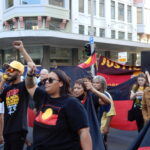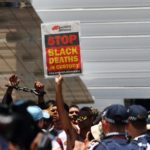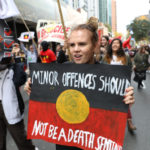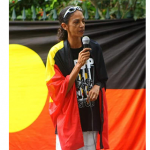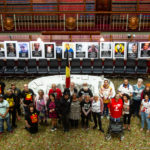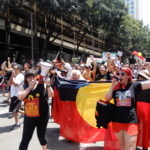Reigniting the Aboriginal Watch Committees: An Interview With Aunty Susie Dixon
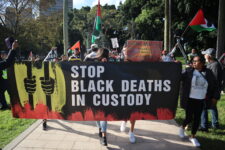
The 15 April this year marked the thirtieth anniversary of the handing down of the Royal Commission into Aboriginal Deaths in Custody final report.
The document was thorough, with most agreeing that the 339 recommendations contained within it provide a clear pathway for reform.
However, on the week of the anniversary, the Guardian reported that at least 474 First Nations custodial deaths had taken place since 1991.
While Corrective Services NSW was still making excuses as to why hanging points haven’t been removed from all cells in line with recommendation 165.
Indeed, in the leadup to the 30 year anniversary a spate of Aboriginal deaths in custody transpired nationally and it has continued on. The ninth custody death since the beginning of March took place in the NSW town of Gunnedah just a fortnight ago.
On the day of the three-decade anniversary, the 30 Years: Still No Justice forum was held at Sydney’s UTS. And amongst the issues touched upon by the First Nations panellists was the need to re-establish the various state Aboriginal Deaths in Custody Watch Committees of the past.
First Nations oversight
The Royal Commission investigated 99 deaths in custody. One of those was the July 1987 death of 19-year-old Kaurna man Kingsley Dixon. The coronial inquest deemed his death a suicide, however his family have never accepted this as a plausible finding.
Following her son’s untimely death within Adelaide Gaol, the late Aunty Alice Dixon became a prominent figure in the national Black rights movement, and she helped establish the South Australian Aboriginal Deaths in Custody Watch Committee.
Aboriginal Watch Committees were set up in each state back then to develop relationships with law enforcement and corrections bodies with the aim of preventing further custodial deaths.
Now Kingsley’s sister, Aunty Susie Dixon, has just reconvened a meeting of the SA Watch Committee. The Kaurna Narungga woman advises that part of the reigniting of the committee system will involve calls to reopen the investigations into specific deaths, with her brother’s case being one of them.
A national convening
Along with the SA Watch Committee, others are reforming within each state and territory. The NSW Aboriginal Watch Committee is about to hold its first meeting, while Queensland and WA are in discussions.
A case that the NSW Watch Committee has prioritised for reinvestigation is the 12 June 1981 death of 21-year-old Gamilaraay man Eddie Murray, who died in the police lockup in Wee Waa.
As detailed in the 1991 report Too Much Wrong, there are many dubious aspects to Murray’s death that remain unexplained.
On 28 September, there is going to be a national meeting of all the state and territory committees in Brisbane. That date marks the anniversary of the 1983 death of 16-year-old Yindjibarndi teen John Pat, who died at the hands of WA police officers.
Sydney Criminal Lawyers spoke to Aunty Susie Dixon about the inadequacies of the systems that are currently in place to deal with deaths in custody, the role of the watch committees will play, and the impact the Royal Commission had upon her family and her brother’s case.
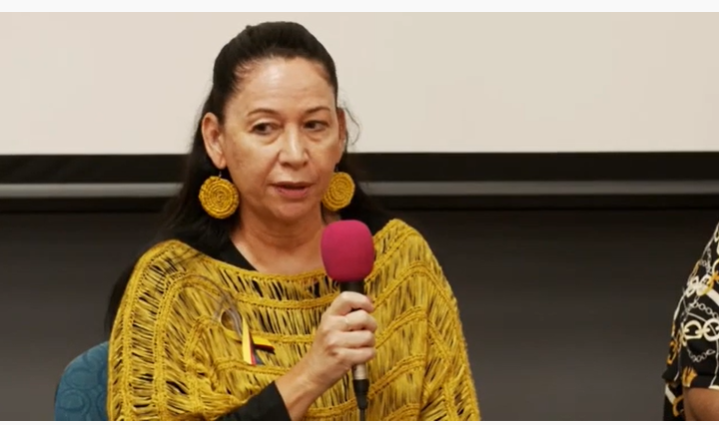
Firstly, there have been nine Aboriginal deaths in custody since March. This adds to the over 470 such deaths since the handing down of the 1991 Royal Commission’s final report.
Aunty Susie, how would you describe the situation with First Nations custodial deaths right now?
The loss of life is devastating. It’s devastating for family members. It’s devastating for the community. It impacts everyone.
It also retraumatises previous families and the communities who haveexperienced past deaths in custody.
Many of these deaths could have been prevented if the authorities were truly committed to implementing the Royal Commission into Aboriginal Deaths in Custody report recommendations.
A lot of information was captured had the potential to prevent further deaths in custody. The final report is a foundational document.
From 1988 to the handing down the report in 1991, 99 deaths were investigated. The information that was captured, including the inadequacies in the system, tells you that if the recommendations were adhered too, there would be prevention of further deaths occurring.
But in saying that, we don’t want people there in the first place. Where are the proactive pathways away from prisons? Where are the social services to provide this?
Part of the big failure with deaths in custody is there is a stronger focus on reconciliation, rather than self-determination. There should be community-led decision-making.
While we have this top-down approach from government, we are going to continue to have deaths, because we don’t have a national lobby group.
That is why when we gathered in Sydney for the 30 Years: Still No Justice panel, we had discussions around re-establishing our state Aboriginal Deaths in Custody Watch Committees so we could come to together nationally as a voice and an avenue for our people.
We need a unified voice, and every state needs their watch committee up and running. They need to be the voice.
So, it’s devastating to be experiencing more deaths, and it’s disappointing because a lot of those deaths could be averted if we were looking at that foundational document and adhering to it.
With the coroner, it is always when someone passes. We are always looking to the past and what we could have done. But we need to reverse that and start looking forwards.
We need to stop the backward thinking and start forward-thinking, so we don’t experience anymore deaths.
The people on the ground in our communities know the social issues that are impacting them because we live in the community.
It’s about addressing those issues we identify, aligning them with the recommendations made in the final report in 1991 and adhering to human rights protocols, especially for our mob in custody.
At the 15 April 30 Years: Still No Justice meeting in Sydney, First Nations panellists and audience members discussed re-establishing the First Nations-run Aboriginal Deaths in Custody Watch Committees.
What would be the role of the committees? And how would they improve on what’s happening currently?
The watch committees will be the voice for their states. It’s envisioned that each state and territory committee will develop relationships with police, correctional services, and other relevant organisations and agencies.
This will be in relation the implementation and the monitoring of the Royal Commission recommendations.
As well, we want to establish diversionary pathways, treatment centres, rehabilitation services and culturally safe trauma counselling. These initiatives will keep our people out of custody.
If you look at rehabilitation, it doesn’t seem like it’s a priority. We have poorly serviced alcohol and other drug services and treatment centres. The watch committees will be advocating for better service delivery to our communities.
Watch committees are on the ground, so they know the families. They know their communities and the issues that are going on within them. They know what’s leading people towards prisons, and the issues that are going on within them.
You have programs like justice reinvestment being established, but for these programs to be truly successful, you need to see Aboriginal and Torres Strait Islander people and communities at the helm.
The watch committees would be seeking a portion of funding that has been earmarked for Reconciliation Australia to be redistributed back to the people on the ground. They’ve already had 30 years of pouring money into reconciliation, and the statistics have gotten worse.
Aunty Jenny Munro pointed out at the 30 Years: Still No Justice forum that the first recommendation to be implemented was the last and that was to work towards reconciliation.
“The cherry picking of the recommendations was a real coup for the government at the time,” Aunty Jenny said. “Remember we started with the last recommendation and not the first.”
Reconciliation has failed us. For the preservation of our communities, we need self-determination.
Self-determination also features in the recommendations, but it hasn’t seen the light of day.
Currently, there are systems across Australia that see police investigating these deaths, which is then followed by a coronial inquiry.
What sort of justice outcomes are these systems providing the First Nations families affected?
They’re not providing justice. Part of what we are asking for is that we have positions attached to the coroner’s office, because those systems are so rigid.
South Australia responded to the 1991 Royal Commission recommendations by asking police to stop investigating police. But this continues to happen. And it leads to findings that are biased and unjust. Investigations relating to a death in custody need to be impartial.
Nothing really comes out of the coronial process. They make recommendations, but it’s the same recommendations being recycled, whether it’s removing hanging points or that prison health services are lacking. It’s the same kind of language for every inquest.
The recommendations are made with no outcome. There are no recommendations going to the Director of Public Prosecutions for any action or accountability.
Coroners can be critical. But there needs to be decisions made with referrals to the DPP.
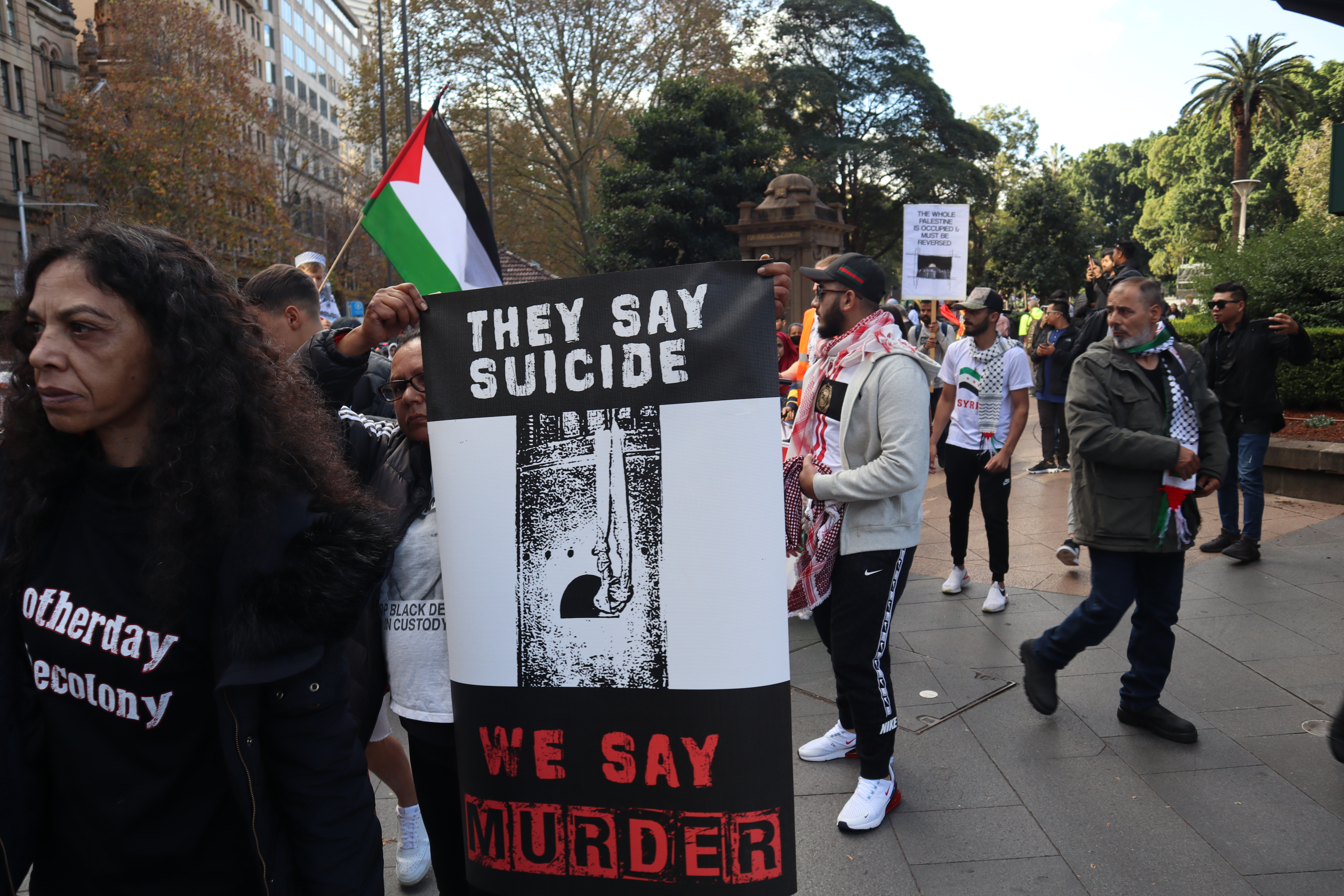
Your brother, Kingsley Dixon died in Adelaide Gaol at the age of 19 in 1987. His death was deemed a suicide, and it was one of the cases investigated by the Royal Commission.
Your family questioned the findings at the time. How do you describe what happened three and a half decades on? How did the justice system serve your family in the wake of your brother’s untimely death?
Kingsley’s was the first death investigated in Adelaide in January 1988. And looking back retrospectively, the Royal Commission was traumatising for our family.
We had to listen to prisoner testimony about my brother getting beatings by prison officers in the remand centre.
We had to sit through discussion of why the prison officers hadn’t tried to revive him, like he was less than human. The officers also criticised nursing staff for trying to revive him.
When the Royal Commission happened, the family members were also investigated.
So, they looked through all my files from school. The whole family was put on trial. They looked at our family dynamics. We were all interviewed and scrutinised. A psychological analysis took place with all family members.
When my brother died, we didn’t accept the findings. The man who did the autopsy, Dr Colin Manock, has questionable pathology qualifications.
When Kingsley’s body was returned to us, he was missing some of his body parts. His stomach and organs were removed, as were his neck muscles. His clothes disappeared from the coroner’s office, so no forensic tests could be undertaken.
A knot expert gave evidence that whoever made the noose was right-handed. They called the knot expert in. My brother was left-handed. That didn’t come up in the coroner’s investigation, but it came up in the Royal Commission.
It was also discovered during the Royal Commission that Kingsley was taken to the infamous A wing – a detention and punishment area –before his death and then returned to his cell.
This information was omitted from official records. The evidence was discovered during the Royal Commission hearings, corrections were charged with falsifying records and received a $50 fine.
That was the only thing that came out of the commission: a $50 fine for falsifying records.
Another case investigated by the Royal Commission was the 1981 death in custody of Eddie Murray in a police cell in the NSW town of Wee Waa.
The NSW Aboriginal Watch Committee is calling for that case to be reopened. Is the SA Aboriginal Watch Committee seeking the reopening of cases in your state?
We are in support of a lot of cases being reopened and looked at, especially because of questions around Dr Colin Manock. He has been under scrutiny for botched autopsies. This included a prisoner being released because of a flawed autopsy.
So, we have great concerns about the way my brother’s autopsy was conducted.
Your mother, the late Alice Dixon established the SA Aboriginal Deaths in Custody Watch Committee in the late 1980s. How did it operate?
My mother, along with Aunty Charlotte Walker, Alan Campbell Junior, the late Kaurno Walker, Ginibi Robinson, the late Esther Williams and Joan Lamont formed the committee. They used to have their meetings at the Aboriginal Community Centre in Wakefield Street. It was voluntary.
They had a memorandum of understanding (MOU) with corrections to get into Yatala Prison and the women’s prison. Inside Yatala, they had a committee called the Sansbury Association.
So, my mother and other members of the SA Watch Committee were able to get regular access and talk to prisoners about reform and diversion. They were proactively looking into how to divert our communities away from the system and navigate them through.
They were looking at the Big Brothers Big Sisters program, where youths are mentored into better pathways. So, it empowers youth.
They had the MOU with the prison because of the Royal Commission. So, there was some good relationship building.
My mother travelled abroad in 1991 presenting a paper about the overincarceration of Aboriginal people. Part of that was a line to land rights and sovereignty – all those issues that Aboriginal people are fighting for.
And lastly, Aunty Susie there have already been discussions and meetings held in NSW, South Australia and Queensland in regard to the new watch committees. A national meeting is set for September.
So, what has been discussed so far?
Each committee is developing a roadmap for change. In South Australia, we’ve been looking at how we can reduce the number of our people going through the system.
We want to deal with the social issues properly. We don’t want superficial, band aid measures.
Change has got to come from the grassroots. Change can’t come from Aboriginal bureaucrats. Some people walk that fine line in working for a department, so they can’t be too political or active in that space because their job could be at risk.
What we’re looking at is that change will come from the community. And the members of the committees represent their communities. They don’t represent a department. Everyone around that table is equal.
Most of the people in the committee have suffered a death in custody. Most, who attended our first meeting, are direct family members. So, we speak through lived experience.
What has been noticeable is that lately voices are being amplified of those who haven’t been directly impacted or affected by a death in custody.
But what we need is for the committee members who have lived experience to have their voices amplified. These are the families who have lost someone in custody and have travelled that journey.
We need to build relationships with the ministers – the corrections minister and the police minister – and start implementing that roadmap for change.
The change is not going to come from someone within the hierarchy, because they’re not on the ground. Those people in positions talk statistics, but we in the watch committees are those statistics.
The government has to look at the way it’s doing business with Aboriginal people. A lot more of it needs to be done with the grassroots people because that’s where change is going to happen.
Change isn’t going to happen by appointing commissioners who are just going to talk about statistics. The watch committee will create a roadmap for change.
That’s social justice change. What leads to deaths in custody is the overrepresentation of our people. We’ve got to look at the bigger picture, and ask, how do we change this?
We know that part of that is our people being overpoliced. We know that it’s racism and stereotyping. It’s social profiling. All of these roads lead to prison.
If you look into the deaths in custody that were investigated by the commission, 55 percent of those people were removed from their families. Then there’s education and employment, as well as access to services, these all play a big role in this.
We don’t need punitive measures like the cashless welfare care. That card is another expensive program to run. And there are simpler ways to deal with that – budgeting.
We are having a lot of financial counselling removed from communities. We have had many other services closed down.
Why are these essential services being closed, when we are at epidemic proportions with deaths in custody and the mass incarceration of our peoples?
We are only 3 percent of the population, but we are up to 29 percent of incarcerations. With youth incarceration in South Australia, sometimes 90 to 100 percent of these youths are Aboriginal. Youth prisons are full of Aboriginal kids.
We need justice reform. The way to prevent deaths in custody is not to be in custody in the first place, so we need to look at all departments: education and child protection, who still remove our children from hospitals. We need to look at all those departments that have those mindsets.
And we need truth-telling. True-telling comes first. Truth-telling comes before reconciliation.
We want to move towards self-determination, and part of that is gathering our watch committees, so we can start putting the real issues on the table.
A Black Lives Matter rally is taking place on Saturday 5 June on Kaurna land marking one year since the first such action took place. The protest will meet at 1 pm at Tarndanyangga-Victoria Square in Adelaide.


